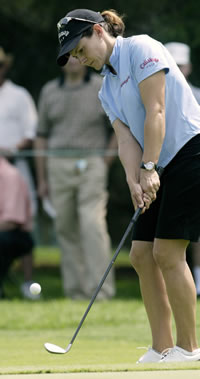 MacGregor Golf has landed a doozy: a great white shark! Greg Norman, two-time British Open Champion (and 47-time Masters runner-up), will play a “full complement” of MacGregor clubs including the MacTec NVG driver and V-Foil M675 forged muscleback irons. Both of these product lines will be launched in January, 2005.
MacGregor Golf has landed a doozy: a great white shark! Greg Norman, two-time British Open Champion (and 47-time Masters runner-up), will play a “full complement” of MacGregor clubs including the MacTec NVG driver and V-Foil M675 forged muscleback irons. Both of these product lines will be launched in January, 2005.
MacGregor plans to use Greg as their primary spokesperson for the MacTec driver, and adds Norman to a cast and crew consisting of two-time Masters winner José Maria Olazabal, two-time U.S. Open winner Lee Janzen, and two-time fashion template Aaron Baddeley. Baddeley was featured in this year’s advertising because, well, when was the last time Olazabal or Janzen won a tournament?
Norman played in eight events this year, including Silly Season Event #1: his own Franklin Templeton “Shark’s” Shootout. Greg turns 50 on February 10 and will most likely split a schedule between the PGA and Champions Tours.

 Is Tiger looking to move to Palm Beach county? Tiger’s yacht, “
Is Tiger looking to move to Palm Beach county? Tiger’s yacht, “ Laura Diaz finished her round with three birdies for a 5-under 67 to take a two-stroke lead in the Mitchell Company LPGA Tournament of Champions. Heather Daly-Donofrio was alone in second after a second-round 66 at the Magnolia Grove’s Crossings Course, and Lorena Ochoa fired a second 68 to tie with Christina Kim (70) three strokes back.
Laura Diaz finished her round with three birdies for a 5-under 67 to take a two-stroke lead in the Mitchell Company LPGA Tournament of Champions. Heather Daly-Donofrio was alone in second after a second-round 66 at the Magnolia Grove’s Crossings Course, and Lorena Ochoa fired a second 68 to tie with Christina Kim (70) three strokes back. The Biltmore Hotel in Coral Gables, FL is being restored. Operating under the City of Coral Gables for several years, the course has suffered from lack of funds and management apathy. The Ross gem, located in old Miami, was far from polished.
The Biltmore Hotel in Coral Gables, FL is being restored. Operating under the City of Coral Gables for several years, the course has suffered from lack of funds and management apathy. The Ross gem, located in old Miami, was far from polished.